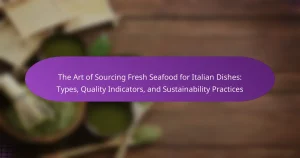
What is Fresh Basil and Why is it Important for Authentic Italian Dishes?
Fresh basil is a fragrant herb commonly used in Italian cuisine. It is a key ingredient in many authentic Italian dishes, such as pesto, Caprese salad, and marinara sauce. Fresh basil adds a distinct flavor profile that enhances the overall taste of these dishes. The aromatic oils in fresh basil contribute to its unique taste and aroma. Its vibrant green color also adds visual appeal to meals. Fresh basil is typically harvested before flowering for optimal flavor. The herb is rich in essential oils and antioxidants, providing health benefits as well. Its importance in Italian cooking is rooted in tradition and culinary heritage.
How does Fresh Basil Enhance the Flavor of Italian Cuisine?
Fresh basil enhances the flavor of Italian cuisine by providing a unique aromatic profile. Its sweet and slightly peppery taste complements many traditional Italian dishes. Fresh basil contains essential oils that release intense flavors when chopped or bruised. This herb is often used in sauces, salads, and as a garnish. For example, basil is a key ingredient in pesto, which is a staple in Italian cooking. Studies show that fresh basil can elevate the overall sensory experience of a dish. Its vibrant green color also adds visual appeal to meals. The use of fresh basil is linked to authentic Italian culinary practices.
What Unique Flavor Profile Does Fresh Basil Offer?
Fresh basil offers a unique flavor profile that is aromatic, sweet, and slightly peppery. This herb has a distinct fragrance that combines hints of mint and clove. The flavor is vibrant and refreshing, making it a staple in Italian cuisine. Fresh basil’s taste can enhance dishes like pesto, caprese salad, and marinara sauce. The essential oils in basil contribute to its rich flavor, particularly eugenol and linalool. These compounds provide the herb’s characteristic warmth and complexity. Overall, fresh basil’s unique flavor profile elevates the taste of many culinary creations.
Why is Freshness Crucial for Basil’s Flavor?
Freshness is crucial for basil’s flavor because it directly impacts the herb’s essential oils and aromatic compounds. These compounds are responsible for basil’s unique taste and fragrance. When basil is fresh, it contains higher concentrations of these oils. As basil ages, it loses moisture and these volatile compounds degrade. This degradation results in a bland and less aromatic flavor profile. Studies show that freshly harvested basil retains about 80% of its essential oils, while dried basil retains only about 20%. Therefore, using fresh basil ensures a more vibrant and authentic flavor in dishes.
What Are the Health Benefits of Fresh Basil?
Fresh basil offers several health benefits. It contains essential oils that have anti-inflammatory properties. These oils can help reduce inflammation in the body. Fresh basil is also rich in antioxidants, which protect cells from damage. Studies show that antioxidants can lower the risk of chronic diseases. Additionally, basil has antibacterial properties that can help fight infections. It may also aid digestion and support heart health. The presence of vitamins A, K, and C further enhances its nutritional value. Regular consumption of fresh basil can contribute to overall well-being.
Which Nutrients are Found in Fresh Basil?
Fresh basil contains several key nutrients. It is rich in vitamin K, which supports bone health. Fresh basil also provides vitamin A, essential for vision and immune function. Additionally, it contains vitamin C, an antioxidant that aids in skin health. The herb is a source of manganese, important for metabolism and bone formation. Fresh basil includes iron, which is vital for blood production. It also has calcium, contributing to strong bones and teeth. Furthermore, basil contains magnesium, which supports muscle and nerve function. These nutrients contribute to the overall health benefits of incorporating fresh basil into your diet.
How Does Fresh Basil Contribute to Overall Well-being?
Fresh basil contributes to overall well-being through its rich nutritional profile and medicinal properties. It contains essential oils, including eugenol, which have anti-inflammatory effects. Additionally, fresh basil is a source of antioxidants that combat oxidative stress. These antioxidants can help protect the body from chronic diseases. Basil also provides vitamins A, C, and K, which support immune function and skin health. Studies have shown that basil may help reduce stress and anxiety levels. The presence of magnesium in basil supports cardiovascular health by improving blood circulation. Furthermore, its antimicrobial properties can aid in digestion and gut health. Overall, incorporating fresh basil into the diet can enhance well-being through these various health benefits.

How Can You Source Fresh Basil for Cooking?
You can source fresh basil for cooking through local farmers’ markets or grocery stores. Farmers’ markets often feature seasonal, locally grown basil. Grocery stores typically stock fresh basil in the produce section. You can also grow basil at home in pots or gardens. Basil thrives in warm weather and needs sunlight. Online retailers offer fresh basil delivery options as well. Many culinary websites provide tips for sourcing and storing fresh basil. Fresh basil is often available year-round in warmer climates.
Where Can You Find Quality Fresh Basil?
Quality fresh basil can be found at local farmers’ markets. These markets often feature organic and locally grown herbs. Grocery stores also carry fresh basil, especially in the produce section. Some specialty food stores focus on high-quality herbs and may offer unique varieties. Additionally, growing basil at home ensures freshness and quality. Home gardening allows for control over growing conditions. Online retailers may provide fresh basil delivery options. These sources ensure access to quality fresh basil for culinary uses.
What Are the Best Local Sources for Fresh Basil?
Farmers’ markets are the best local sources for fresh basil. They offer a variety of basil types directly from local growers. Many farmers’ markets feature organic options. Local grocery stores may also carry fresh basil, often sourced from nearby farms. Community-supported agriculture (CSA) programs provide fresh basil through subscriptions. Some specialty grocery stores focus on local produce and may stock fresh basil. Additionally, local herb farms sell fresh basil directly to consumers. These sources ensure the basil is fresh and flavorful for culinary uses.
How Do Farmers’ Markets Compare to Grocery Stores for Fresh Basil?
Farmers’ markets typically offer fresher basil than grocery stores. Freshness is crucial for flavor and aroma in culinary uses. Basil from farmers’ markets is often harvested the same day. This contrasts with grocery store basil, which may be several days old. Additionally, farmers’ markets often provide organic options. Organic basil is grown without synthetic pesticides or fertilizers. Studies show that fresh basil retains higher nutrient levels when consumed quickly after harvest. Farmers’ markets also support local agriculture, enhancing community sustainability. In contrast, grocery stores may source basil from distant farms, impacting freshness. Overall, farmers’ markets generally provide superior quality and taste for fresh basil.
What Should You Look for When Buying Fresh Basil?
Look for vibrant green leaves when buying fresh basil. The leaves should be firm and free of blemishes. Avoid wilted or discolored leaves, as they indicate poor quality. Fresh basil should have a strong, aromatic scent. This aroma signifies freshness and flavor intensity. Check the stems for firmness; they should not be woody. Fresh basil is best when purchased in small quantities, as it wilts quickly. Organic basil is often preferred for its flavor and lack of pesticides.
How Can You Identify Fresh Basil at the Market?
Fresh basil can be identified at the market by its vibrant green leaves. The leaves should be smooth and not wilted or discolored. Look for a strong, aromatic scent, which indicates freshness. Fresh basil should feel firm and not limp to the touch. Additionally, check for intact stems; they should be green and not brown. Avoid any bunches with yellowing leaves or signs of browning. These characteristics ensure that the basil is fresh and suitable for culinary uses.
What Signs Indicate Poor Quality in Fresh Basil?
Signs indicating poor quality in fresh basil include wilted leaves, discoloration, and a slimy texture. Fresh basil should have vibrant green leaves. If the leaves are yellowing or brown, it suggests age or spoilage. A slimy texture often indicates bacterial growth. Additionally, a strong, unpleasant odor may signal decay. Fresh basil should have a fragrant, sweet aroma. If the stems are dry or brittle, the basil is likely past its prime. These signs help ensure the selection of high-quality basil for culinary uses.

When is Fresh Basil in Season?
Fresh basil is in season primarily during the warmer months. This typically ranges from late spring to early fall. In most regions, fresh basil is best harvested from May to September. During this time, the plant thrives in warm temperatures and ample sunlight. Gardeners and farmers often report peak flavor and aroma during these months. Fresh basil is less available and flavorful in winter months. This seasonal availability is crucial for authentic Italian dishes that rely on fresh herbs.
What Are the Peak Seasons for Fresh Basil?
Fresh basil peaks during the warm months, primarily from late spring to early fall. This period typically spans from May to September in most regions. The plant thrives in temperatures between 70°F and 90°F. During these months, basil is most flavorful and aromatic. The availability of fresh basil coincides with its growing season. Harvesting occurs just before flowering for optimal taste. In cooler climates, indoor growing can extend the season. Gardeners often plant basil after the last frost for best results.
How Does Seasonal Availability Affect Flavor and Quality?
Seasonal availability significantly impacts the flavor and quality of fresh basil. During peak growing seasons, basil tends to have a more robust flavor profile. This is due to optimal growing conditions such as temperature, sunlight, and soil quality. Conversely, basil harvested out of season often lacks the same intensity of flavor and may be of lower quality. Research indicates that basil grown in ideal conditions can produce higher essential oil content, enhancing its aromatic properties. Therefore, sourcing basil during its natural growing season ensures the best flavor and quality for culinary uses.
What Regions Produce the Best Fresh Basil During Different Seasons?
Italy, particularly the regions of Campania and Liguria, produces the best fresh basil. Campania is known for its fragrant Genovese basil, thriving in warm summer months. Liguria also has a rich basil production, especially during the same season. In the United States, California is a leading region for basil cultivation, primarily in the summer. Other areas like Florida and Texas contribute to basil production, particularly in warmer months. The ideal climate for basil includes warm temperatures and ample sunlight. These conditions enhance the flavor and aroma of the herb, making it suitable for culinary uses.
How Can You Store Fresh Basil to Maintain Its Quality?
To store fresh basil and maintain its quality, keep it in a glass of water like a bouquet. Place the basil stems in the water and cover the leaves loosely with a plastic bag. This method keeps the basil fresh for about a week. Alternatively, you can wrap the basil in a damp paper towel and place it in a sealed plastic bag in the refrigerator. This can also help retain moisture and flavor. Avoid washing the basil until you are ready to use it. Washing can introduce excess moisture that promotes decay. Proper storage prevents wilting and keeps the basil aromatic for culinary uses.
What Are the Best Practices for Storing Fresh Basil?
To store fresh basil, keep it in a cool, dry place. Placing the stems in a glass of water can help maintain freshness. Cover the leaves loosely with a plastic bag to retain moisture. Alternatively, wrap basil in a damp paper towel and place it in a sealed container. Refrigeration can cause browning, so avoid it if possible. Fresh basil typically lasts about a week when stored correctly. Research indicates that proper storage can extend the shelf life of herbs significantly.
How Long Can You Expect Fresh Basil to Last When Properly Stored?
Fresh basil can last up to two weeks when properly stored. Storing basil in a glass of water, like a bouquet, can extend its freshness. Alternatively, wrapping basil in a damp paper towel and placing it in a sealed bag in the refrigerator can also work. These methods help maintain humidity and prevent wilting. Research indicates that proper storage techniques significantly affect the longevity of herbs.
What Are Some Culinary Uses for Fresh Basil in Italian Dishes?
Fresh basil is widely used in Italian dishes for its aromatic flavor. It enhances sauces, particularly in marinara and pesto. Basil is often added to salads, such as Caprese, which combines tomatoes and mozzarella. It can also be used as a garnish for pizzas and pasta dishes. Additionally, fresh basil is integral in flavoring oils and vinegars. Its vibrant leaves complement roasted vegetables and meats. The herb is typically added at the end of cooking to preserve its flavor. Fresh basil is a staple in traditional Italian cuisine, contributing to the authenticity of many recipes.
How Can Fresh Basil Be Incorporated into Traditional Italian Recipes?
Fresh basil can be incorporated into traditional Italian recipes by using it in sauces, salads, and as a garnish. In classic dishes like pesto, fresh basil serves as the primary herb, blended with garlic, pine nuts, Parmesan cheese, and olive oil. In Caprese salad, fresh basil complements tomatoes and mozzarella, enhancing flavor and presentation. Basil can also be added to marinara sauce during cooking for an aromatic depth. Additionally, it can be sprinkled on pizzas just before serving to preserve its flavor. These uses highlight basil’s versatility in Italian cuisine, making it a staple ingredient in many recipes.
What Are Some Creative Ways to Use Fresh Basil in Cooking?
Fresh basil can be used creatively in various culinary applications. One way is to make basil pesto, blending fresh basil leaves with garlic, pine nuts, Parmesan cheese, and olive oil. This versatile sauce can enhance pasta, sandwiches, or pizzas. Another method is incorporating basil into salads, where it can add a fresh, aromatic flavor. Basil can also be infused into oils or vinegars, creating unique dressings and marinades. Additionally, it pairs well with fruits like strawberries and watermelon, providing a refreshing contrast. Cooking with basil in soups or stews can elevate the dish with its aromatic qualities. Lastly, fresh basil can be used as a garnish for cocktails, adding a fragrant touch.
What Tips Can Help You Make the Most of Fresh Basil in Your Kitchen?
To make the most of fresh basil in your kitchen, store it properly. Place basil stems in a glass of water like a bouquet. Cover the leaves with a plastic bag to maintain humidity. This method keeps basil fresh for up to a week. Use basil in dishes like pesto or salads for maximum flavor. Chopping basil finely releases essential oils, enhancing its aroma. Add basil towards the end of cooking to preserve its flavor. Pair basil with tomatoes and mozzarella for classic Italian dishes. Experiment with basil in cocktails for a unique twist.
Fresh basil is a vital herb in authentic Italian cuisine, known for its aromatic and flavorful contributions to dishes like pesto, Caprese salad, and marinara sauce. This article explores the importance of sourcing fresh basil, its health benefits, and how to identify quality basil at markets. It details the peak seasons for fresh basil, best storage practices, and various culinary uses, emphasizing its role in enhancing the authenticity of Italian recipes. Additionally, readers will learn how to incorporate fresh basil creatively in cooking and the nutritional advantages it offers.


